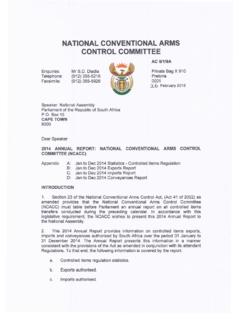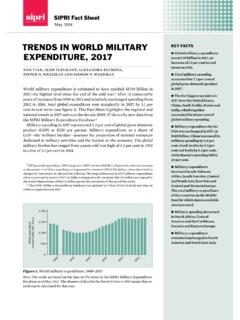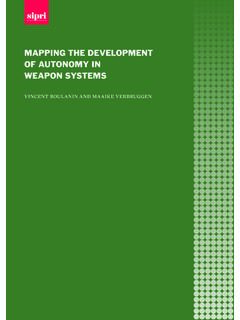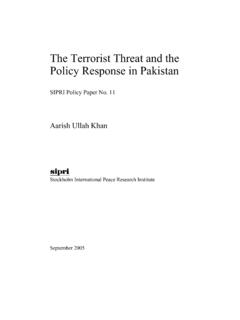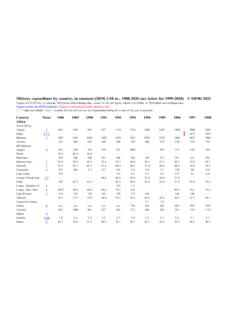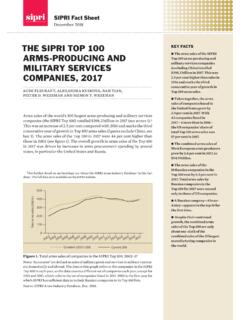Transcription of SIPRI Yearbook 2020, World Nuclear Forces, 2020
1 SIPRI Yearbook 2020: Armaments, Disarmament and International Nuclear forcesOverviewAt the start of 2020, nine states the United States, Russia, the United Kingdom, France, China, India, Pakistan, Israel and the Democratic People s Republic of Korea (DPRK, or North Korea) possessed approximately 13 400 Nuclear weapons, of which 3720 were deployed with operational forces (see table ). Approximately 1800 of these are kept in a state of high operational , inventories of Nuclear warheads continue to decline. This is primarily due to the USA and Russia dismantling retired warheads. At the same time, both the USA and Russia have extensive and expensive programmes under way to replace and modernize their Nuclear warheads, missile and aircraft delivery systems, and Nuclear weapon production facilities (see sections I and II).
2 The Nuclear arsenals of the other Nuclear -armed states are considerably smaller (see sections III IX), but all are either developing or deploying new weapon systems or have announced their intention to do so. China is in the middle of a significant modernization and expansion of its Nuclear arsenal, and India and Pakistan are also thought to be increasing the size of their arsenals. North Korea continues to prioritize its military Nuclear programme as a central element of its national security strategy, although in 2019 it adhered to its self-declared mora toria on the testing of Nuclear weapons and long-range ballistic missile delivery systems. The availability of reliable information on the status of the Nuclear arsenals and capabilities of the Nuclear -armed states varies considerably.
3 The USA has disclosed important information about its stockpile and Nuclear capabilities, but in 2019 the administration of President Donald J. Trump ended the prac tice of disclosing the size of the US stockpile. The UK and France have also declared some information. Russia refuses to publicly disclose the detailed break down of its forces counted under the 2010 Treaty on Measures for the Further Reduc-tion and Limit ation of Strategic Offensive Arms (New START), even though it shares the infor mation with the USA. China now publicly displays its Nuclear forces more frequently than in the past but releases little information about force numbers or future develop ment plans. The governments of India and Pakistan make state ments about some of their missile tests but provide no inform ation about the status or size of their arsenals.
4 North Korea has acknowledged con-duct ing Nuclear weapon and missile tests but provides no inform ation about its Nuclear weapon capabilities. Israel has a long-standing policy of not comment-ing on its Nuclear arsenal. 326 military spending and armaments, 2019 The raw material for Nuclear weapons is fissile material, either highly enriched uranium (HEU) or separated plutonium. China, France, Russia, the UK and the USA have produced both HEU and plutonium for use in their Nuclear weapons; India and Israel have produced mainly plutonium; and Pakistan has produced mainly HEU but is increasing its ability to produce plutonium. North Korea has produced plutonium for use in Nuclear weapons but may have produced HEU as well.
5 All states with a civilian Nuclear industry are capable of producing fissile materials (see section X).shannon n. kile and hans m. kristensenTable World Nuclear forces, January 2020 All figures are approximate. The estimates presented here are based on public information and contain some uncertainties, as reflected in the notes to tables of first Nuclear testDeployed warheadsaStored warheadsbOther warheadsTotal inventoryUnited States19451 750c2 050d2 000e5 800 Russia19491 570f2 745g 2 060e 6 375 United Kingdom195212095 215hFrance196028010..290 China1964 320 320 India1974 150..150 Pakistan1998 160..160 Israel.. 90..90 North Korea2006 ..[30 40][30 40]iTotalj3 7205 6204 06013 40 0.. = not applicable or not available; = zero; [ ] = uncertain : SIPRI revises its World Nuclear forces data each year based on new information and updates to earlier assessments.
6 The data for Jan. 2020 replaces all previously published SIPRI data on World Nuclear These are warheads placed on missiles or located on bases with operational These are warheads in central storage that would require some preparation ( transport and loading on to launchers) before they could become fully operationally This figure includes approximately 1600 strategic warheads (about 1300 on ballistic missiles and nearly 300 on bomber bases), as well as c. 150 non-strategic (tactical) Nuclear bombs deployed outside the USA for delivery by US and other North Atlantic Treaty Organization This figure includes c. 80 non-strategic Nuclear bombs stored in the This figure is for retired warheads awaiting This figure includes approximately 1370 strategic warheads on ballistic missiles and about 200 deployed at heavy bomber This figure includes c.
7 870 warheads for strategic bombers and Nuclear -powered ballistic missile submarines (SSBNs) in overhaul and c. 1875 non-strategic Nuclear weapons for use by short-range air, air defence and naval The British Government has stated that the process to reduce the stockpile to 180 warheads is under way. Although some sources suggest that the stockpile remains at 215 warheads, it is possible that, under this process, the stockpile may have already been reduced to 195 warheads. i There is no publicly available evidence that North Korea has produced an operational Nuclear warhead for delivery by an intercontinental-range ballistic Totals do not include figures for North Nuclear forces Nuclear forceshans m.
8 KristensenAs of January 2020, the United States maintained a military stockpile of approximately 3800 Nuclear warheads, roughly the same number as in January 2019. The stockpile included approximately 1750 deployed Nuclear war heads, consisting of about 1600 strategic and 150 non-strategic (or tac-tical) warheads. In addition, about 2050 warheads were held in reserve and around 2000 retired warheads were awaiting dismantlement (385 fewer than the estimate for January 2019), giving a total inventory of approxi mately 5800 Nuclear warheads (see table ).The USA reached compliance with the final warhead limits prescribed by the 2010 Treaty on Measures for the Further Reduction and Limit ation of Strategic Offensive Arms (New START) by the specified deadline of 5 February 2018, at which point it was reported to have 1393 deployed war-heads attributed to 660 deployed strategic launchers that is, deployed inter continental ballistic missiles (ICBMs), deployed submarine-launched ballistic missiles (SLBMs)
9 And deployed heavy As of Septem-ber 2019, the New START aggregate numbers showed the USA deploying 1376 warheads attributed to 668 deployed strategic The number of deployed warheads reported under New START differs from the estimate presented here because the treaty attributes one weapon to each deployed bomber even though bombers do not carry weapons under normal circum-stances and does not count warheads stored at bomber modernizationIn 2019 the administration of President Donald J. Trump continued to imple-ment the 2018 Nuclear Posture Review (NPR).3 The NPR recommended main tain ing the comprehensive Nuclear weapon modernization pro-gramme decided by the previous administration but with several new Nuclear weapons and an increase in the production of plutonium cores for Nuclear weapons.
10 Specifically, the NPR outlined plans to introduce a new class (Columbia) of Nuclear -powered ballistic missile submarine (SSBN); a new Nuclear - capable strategic bomber (B-21 Raider); a new long-range 1 US Department of State, Office of the Spokesperson, Key facts about New START implementation , Fact Sheet, 5 Feb. 2018. For a summary and other details of New START see annex A, section III, and chapter 11, section I, in this US Department of State, Bureau of Arms Control, Verification and Compliance, New START Treaty aggregate numbers of strategic offensive arms , Fact Sheet, 1 Sep. US Department of Defense (DOD), Nuclear Posture Review 2018 (DOD: Arlington, VA, Feb.)

